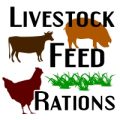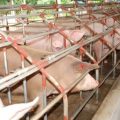Raising pigs is a popular enterprise in the Philippines. Processing its meat is just one part of this proliferating industry. Processing its skin, a by-product, is another significant economic activity, the potentials of which the swine industry can take full advantage of.
Taking into consideration the call of the government to promote the country’s native animals and optimize their potentials, the Animal Products Development Center (APDC) of the Bureau of Animal Industry (BAI) embarked on a study to develop improved processing technologies for meat and skin from native pig (Black Tiaong strain). The twoyear study titled, “Improvement of Processing Technologies for Meat and Skin from Black Tiaong Strain of Native Pig”, was led by Nenita R. Estante of APDC. Funded by the Bureau of Agricultural Research (BAR), the study aimed to characterize the carcass of native pig, develop meat products, and improve tanning techniques for its skins. According to Estante, the project aspired to increase the public’s awareness on the use of native pork for food and of pig skin as leather given the improved technologies on processing developed by this study.
Potentials of Black Tiaong native pig
With the growing demand for pork, local production could hardly keep up and is one reason for large importations. One of the ways to meet the local demand is by increasing the potentials of native pig as food which studies have shown to be a healthier choice to the usual commercial pork. According to Estante, “native pigs are already becoming extinct, thus utilizing them would not only help meet local demand for pork but also help increase the profits of native pig producers/livestock raisers and meat processors.”
Physically, native pigs possess characteristics that are distinct to them. They are usually pure black or sometimes spotted. They have a long face, long snout, erect ears, and short and low set of body conformation. They have small body size and have slow growth rate compared to commercial ones. They thrive well and reproduce under natural environment. The young native pig (13-73 days old) usually weighs 2-13 kg while the adult (6-9 months) weighs 30-35 kg.
Native pigs are not picky eaters; they can live on feed ingredients that are farm-grown or locally-available that include gabing San Fernando (Yautia sp.), sweet potato, banana trunks and leaves, rice bran, and even vegetable rejects. Native pigs are stronger and have high resistance to parasites and diseases. They can easily adapt to local conditions and can tolerate hot and cold weather. They need less management requirement and require minimal expense on housing facility. Since they can be grown organically (without commercial feeds and chemical inputs), they have high economic advantages for organic swine producers.
The Black Tiaong (BT Black) is a breed developed by BAI through crossbreeding strains of native pigs from Benguet, Marinduque, and Quezon. It has faster growth rate compared to other pure native pigs and still retains its good characteristics. BT Black is known for its pure black color. The boars have pricked or erect ears while those of the female are semi-lopped to pricked or erect. The sows have good mothering ability and good litter size of eight piglets. A two-month BT black weighs an average of 9 kg while a five-month old can weigh 35 kg. The meat of BT black is excellent for lechon.
Native pig, the healthier choice
The increasing number of health-conscious consumers opens up opportunities for native pigs as a healthier choice of meat. And since native pigs are mostly organicallygrown, preference for native pig lechon has led to the growth of local demand for native pigs which calls for higher production. The premium price that they command and their health advantages give economic encouragement for swine growers to consider native pigs.
In the study of Estante, the carcass of the BT strain of native pig was flayed and evaluated for yield and quality characteristics. Freshly cooked meat was subjected to sensory evaluation. Results of the meat quality chemical analysis showed that native pork is higher in moisture, crude protein, and ash content than commercial pork. It was also found that native pork is lower in crude fat, carbohydrates, food energy, calorie from fat, and cholesterol content than commercial pork.
When it comes to cholesterol content, native pork has lower levels than commercial pork at 22.40mg/100g. With its lower cholesterol content, it serves as the best choice of meat for older and health-conscious people.
Meat products from native pork
One of the main objectives of the APDC study was to characterize the quality of meat of native pigs and develop processing technologies for its meat products so that they do not only taste good but are also healthy and have long storability.
Recipes were standardized and then subjected to consumer tests and shelf life studies. Among the meat products included in the study were: lechon, smoked bacon, fresh native sausage (longanisa), hotdog, and dried tapa (pork jerky).
Standardization of the native pork lechon recipe was done using the parameters of skin color, meat color, flavor, crispiness of the skin, juiciness, tenderness, and general acceptability. Meanwhile, in the standardization of recipes for developed native meat products, these were subjected to evaluation as to their sensory attributes (i.e., color, flavor, saltiness, sourness, toughness, smoked flavor, and general acceptability).
Results of the consumer taste test showed that almost all of the respondents liked the lechon, smoked bacon, fresh native sausage, and hotdog, with most appreciating the dried tapa (jerky).
All developed products from native pigs were vacuum packed to seal in the freshness and ensure longer storability. Results for the shelf life studies showed that hotdog lasted for one day at Room Temperature (RT), 8 days at Chiller Condition (CC), and 35 days at Freezer Condition (FC). Fresh native sausage lasted for 2 days at RT, 3 days at CC, and 97 days at FC while vacuum packed smoked bacon lasted for 6 days at RT, 7 days at CC, and 70 days at FC. For dried tapa, the group of Estante recommended the use of anti-mold agent to prevent the growth of yeasts and molds.
Economic potential of native meat products
Given its unique flavor and leaner meat quality, the price of native pig is higher than that of commercial pig. The price of a 14-kg standardized native lechon costs around P7, 042.00 with production cost of P5,865.62compared to a 14-kg commercial lechon which costs around P4,200.00 – P5,600.00. This trend goes the same for other native pig products.
Thirty kilos (30kg) of native pork can produce 31 kg of hotdog which costs around P6,882.00. Production cost is P5,732.13 for a profit of P1,149.87. Meanwhile a kilo of native pork can make 1.30 kg of fresh native sausage which costs around P326.30. With a production cost of P272.07, it can provide an earning of P54.23. A 10-kg of native pork can produce 7.90 kg of smoked bacon which can be sold for around P3, 989.50. With a production cost of P3, 327.60, there is an earning of P661.90.
Dried tapa from native pork is not yet available in the market which is limited to fresh tapa, thus this is a good opportunity to introduce this new product to consumers. A kilo of native pork can produce 310 grams of dried tapa that costs around P408.90 providing an earning of P68.12 for a kilo of native meat.
Safer tanning technique for native pigskin
Aside from carcass characterization and development of meat products, the study looked into the tanning technique of the native pig’s skin as this material can be another source of income for growers. Specifically, the study looked into the potential of natural replacements to the ingredient, Nonylphenol Ethoxylates (NPE), as degreasing agent for tanning pigskins.
Native pigskin leather has a distinctive grain structure due to the hair penetrating through the useable grain layer that leaves holes which, along with other pores, makes for “breathing leather” that allows air ventilation which is important for leatherwear such as shoes, gloves and jackets. However, pigskin has high deposits of fat in it, thus, the need to degrease them properly. Degreasing is an essential part of the tanning procedures particularly for native pigskin. Improper degreasing can result to improper quality tanning and reduce the longevity of the leather.
The leather industry is a thriving sector in the country generating jobs for many Filipinos. Leather from the skins of animals such as cattle and carabao is one of the most important economic byproducts of the meat industry.
A search for suitable replacements for NPE as a degreasing agent for removing the fat from the native pig’s dermis was made under the study. This chemical has been banned in the international market because of its ill effects on the environment and human health. It is not easily degraded and is also costly.
The group of Estante looked into the potential of using pig’s bile and paraffin as natural replacements to NPE. Pig’s bile and paraffin are cheaper and are easily degraded in the environment.
The study conducted five treatments and three trials. To determine the quality of the resultant leather from the five treatments, the pigskin was subjected to fat analysis and physico-chemical tests. Using pig’s bile and paraffin to replace NPE, results of the treatments produced acceptable outcomes in terms of fat content, tensile strength, elongation at break, and thickness for leather.
The use of paraffin and bile as replacements for the harmful chemical in degreasing the skin was shown to give good results as the leather passed the quality parameters based on international standards. ### Rita T. Dela Cruz http://www.bar.gov.ph
For more information about the project, please contact Nenita R. Estante, Project Leader, Animal Products Development Center (APDC), Bureau of Animal Industry (BAI), Marulas, Valenzuela City. Tel. No: +63 (2) 291 6834, Email: apdcmarulas@gmail.com






